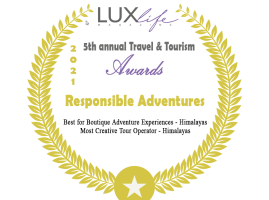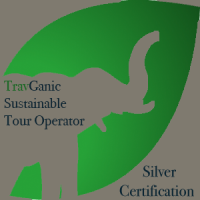Annapurna Circuit trek with Tilicho Lake during winter. January 2018.
Andrew and I had agreed to discuss a second trek on which he could go after his family trek on our communications. We decided to go on the Annapurna Circuit with Tilicho Lake. It met his requirements of relatively easy accessibility, which could be done within two weeks, visiting a glacial lake and going over 5000 meters. We decided to start on the 8th of January, two days after his family left for Hong Kong. While Andrew was in Pokhara and Chitwan with his family, I returned to Kathmandu to get the necessary permits, the needed information, etcetera.
The Drive to Besishar.
We had agreed to hire a car from Besisahar to a blacktopped road; from Besisahar, we had to hire a local Indian jeep. My local transporter in Besisahar advised me to start from Kathmandu early as a small section of the road freezes in the late afternoon. Andrew and I agreed to leave Kathmandu at 5 am with some packed breakfast and coffee to avoid the frozen section of the fair-weather road to Chame – our destination for the first night. I went to pick up Andrew with a slight delay as the designated driver’s mother-in-law turned ill, and he had to be replaced by another person. We managed to get out of Kathmandu valley smoothly as it was still early. Driving into or out of Kathmandu can be nightmarish, with delays as long as 3-4 hours. We had clear views of the Manaslu and Annapurna range on the drive to Besisahar. We reached Besishar on schedule after 5 hours of driving.
Besisahar to Chame Drive. 2600m.
We changed vehicles and were driven off after showing the permits to the registrar. Andrew and I had booked a whole jeep – Mahendra Bolero for us. I asked the driver to call a restaurant to make dal bhat (Nepalese staple diet) in advance to save time. The road was rough with huge rocks making it very bumpy for the first half. We stopped for a quick lunch, which was ordered in advance. We picked up a few hitchhikers, including a goat with difficulty walking. The road became less bumpy once we entered the district of Manang. We managed to get through several icy parts of the way with no trouble and arrived at Chame at 5 pm, 11 hours since we left Kathmandu. The views of the mountains from the Manaslu range to the east and Lamjung Himal to the south were unobstructed all day long, despite nearly 30 years of trekking I had never experienced. We checked into a lovely lodge with cottages and had the whole place to ourselves.
We went to our cabins to sort everything for the night before gathering in the dining room, where pleasant warmth from the heater welcomed us. We had some Rakshi (locally distilled drink). We checked out the weather forecast on the Internet, and the predictions for Manang village, 3500meters, were -18 minimum and -9 maximum. We were getting there in two days. The temperature for Throung La past the 16th of January was forecasted to be -11 maximum and -24 minimum. This raised some concerns for me. We went to bed early after Andrew roughly ground the coffee beans he had brought to get the well-needed rest. We woke up at 7 am, packed our backpacks, and met in the dining room for fresh coffee, which Andrew had ground the previous evening. The weather app on our devices showed the temperature to be -9 degrees Celsius; I was wearing a pair of socks and my slippers – my feet did not feel cold or uncomfortable. I shared this with Andrew and mentioned this felt odd, but the lack of discomfort was welcome at the same time. However, the water in the bucket inside the toilet was frozen solid, while the toilet floor was icy with the spilt water.

The Trek to Upper Pisang 3200m.
This was a short day of five hours of trekking amidst beautiful scenery. We decided to take our time to absorb the surrounding beauty and took many photographs. We passed through a series of Mani walls. We arrived at the apple orchards at Brathang and stopped at the farmhouse for some hot lemon drinks. We were down to our T-shirts by this time, which was a pleasant surprise, having been at supposedly -9 degrees Celsius just a few hours ago. We had to climb a moderate hill after crossing a bridge; we went through Juniper, Pine, and Fir forests. The valley began to broaden, and Pisang Peak 6091m stood in front of us, while in the back were the impressively broad rock walls the locals call “Heaven’s gate.” We stopped at Dhikur Pokhari for lunch. We had a short walk to Upper Pisang after lunch. While walking on the fair-weather road track, Andrew slipped on ice camouflaged by dirt. It quickly reminded us that we were, after all, trekking in the Himalayas during winter. We saw less than ten trekkers on this day. We stayed at Tukuche lodge at Upper Pisang, and there were two backpackers there; one Swedish and the other one from South Korea.
Trek to Manang Village.
There are two options to get to Manang – the shorter lower route or, the more extended but more scenic Upper route. We opted for the more beautiful and higher way, which also helps with acclimatization to high altitudes. We started around 8.30 am and were in the sun after thirty minutes of hiking. We walked above a picturesque lake to our left. We walked on a reasonably level path through scrubland before coming across a long Prayer wall, descended a little to cross a stream on a suspension bridge, and began a strenuous climb with switchbacks to the village Ghyaru 3673m. We were greeted by Lamjung Himal’s views, Annapurna II, IV, III, Gangapurna, and Mount Tilicho. We had a short stop to rehydrate and take photos before proceeding with our trek. We had to negotiate carefully around the communal tap as it was very icy. The villagers let the taps run through the winter to prevent solidly freezing, which breaks the pipes; there was also ice where the villagers threw used water. We contoured the hills turning back to admire the beauty behind us.
We were hiking above the Marshyangdi river valley until we reached Ngawal, where we stopped for lunch. Unfortunately, the toilets at the lodge we stopped at for lunch were blocked due to the cold. We were informed that the toilets de-freeze around 3 pm and freeze again after sundown. After lunch in the Marshyangdi valley, we started descending after lunch and trekked for a further ninety minutes passing Braka village before arriving at Manang village. The only people we saw on the trail were the Swedish, South Korean guy who stayed at the same lodge the previous night and a French trekker and his guide. There was a lone Korean Trekker and a Korean couple with their guides and porters at the Tilicho Hotel in Manang. Worried about the temperature forecast, saying Manang would experience -18 degrees, I had a blanket and two thick quilts on top of me and my microfleece and Kathmandu X series jacket with the hood over my head when I went to sleep. I woke up around 4.20 am sweating; I had to take the top quilt off me – pleased that the weather forecast was incorrect.
Manang Acclimatization day.
We had a lazy start on this day after a restful night. The 3 Koreans left without having a day for acclimatization. The Korean girl was not feeling well, but her porter/guide insisted they continue. Andrew and I heard the conversation; got concerned for her. We both spoke about her and hoped she would be fine. We decided to find out if any of the “movie halls” showed some films, only to find out that all the owners had gone down to warmer places like Kathmandu, Pokhara, and Chitwan. More than half the lodges and most shops were closed for winter. We walked around the village and went a little out of a town to a place where an old and a new monastery were under construction. We just hung around admiring the stunning views and the sun’s warmth until lunchtime. I had a lovely hot shower in the afternoon and sat around reading articles on the Internet. At about 4 pm, a group of 3 German trekkers and a South African trekker came to the lodge with their guides and porters. We had a lovely Manang stew meal with super hot chilly sauce, which warmed us till we were sweating. It was 30 years since I had returned to Nepal and celebrated with a slice of apple pie each. The German trekkers and their guide started drinking beer after dinner while playing card games; I heard them speaking loudly on the way to their rooms around 12.30 am – it sounded like they had good fun. I woke up around 2.30 am, perspiring again from the extra warmth of the quilt and blankets; I fell asleep again after removing the second quilt – pleased I was hot rather than cold.

Manang to Tilicho Base Camp 4170m.
We started through the Western gates of Manang, followed a path down to a river we crossed, and continued to the south side, passing through a coniferous forest. We crossed a suspension bridge and continued towards Khangsar Village. Upon reaching Khangsar, some Nepali trekkers informed me that the lodges at Shree Kharka were closed. We had planned to have lunch there. We went to a hostel, hoping to buy some snacks to sustain us until we got to Tilicho base camp, only to be told they did not have any. We had some almonds we had purchased in Chame and were confident that it would keep us going until we reached Tilicho Base Camp for late lunch. We left Khangsar after having hot drinks, reaching Shree Kharka after 90 minutes. We arrived at a landslide area with a mixture of scree and rocks with quite steep descent with loose grit. We saw a big flock of Blue Sheep just before the landslide and a flock of partridges. It took us 75 minutes to negotiate the landslide area; the villagers have made the trail about 2-3feet wide in the recent two years; before the broadening of the path, there were parts where some people had to be on all fours to get across.
There are also articles about some trekkers having slid down 200-250 meters and scrambled back to the main trail. We had late lunch, and a Korean photographer with his porter, a Swedish guy who wanted to go over Mesokanto pass to Jomsom but decided to turn back as there was snow, and the wind was strong. A group of 7 Nepali trekkers had driven to Shree Kharka the previous day and continued to base camp. They went on to Tilicho Lake this morning without proper acclimatization; even we, Nepalese, need to give our body enough time to adjust to the altitude’s lack of oxygen. They arrived at the lodge in the evening while admiring the beautiful sunset with 3 South African Siblings and a lone French trekker who came to the base camp after us. The Nepalese youths were exhausted and dehydrated, but fortunately, no one was hurt. We went to bed around nine as usual; there was strong wind around 1 am; it felt like it would blow the roofs off the lodge. However, Andrew and I stepped out of our rooms to go to the toilet – we were surprised that the wind was not cold.
Tilicho Lake 4980m and back to Khangsar.
We started heading towards Tilicho Lake after light around 7.30. The hike begins with a steep ascent of 30 minutes before the climb’s gradient becomes gentler. We reached a set of switchbacks a further hour before reaching the top. The trail is undulating for 30 minutes before arriving at the lake. We would see strong gusts of wind blowing clouds in the southeast, high above us clouds, and the snow blown off Mount Tilicho and Mount Khangsar Khang. We were greeted by strong wind gusts from the West when we reached Tilicho Lake. We saw some Himalayan Snow Cocks and a giant Male Blue Sheep on the way to the lake. Most of the surface was frozen, and the strong winds blew snow everywhere. It had snowed lightly on the 2nd of January on the mountains and higher elevations.
We stopped to take photos and appreciate the scenery before returning as we had a long walk back to Khangsar village, as the lodges at Shree Kharka were shut for winter. We had sand and grit in our mouths from breathing the dust blown by the strong winds on our way down to base camp. We finished packing our backpacks before lunch at base camp and started to retrace our steps first through the landslide area. The gusts of wind had destabilized the rocks and scree; not too long after we started, we narrowly missed a series of rockfalls in a few places. We had to take turns trekking while the others waited in a safer area to warn each other of falling rocks. It took us 15 minutes less to get through the landslide despite the path being uphill as we walked most of the way briskly. The wind had also caused scree and rock to slide on the trail, where we had to scramble across to avoid falling down the slope. Once we were off the landslide area, we covered very well and reached Khangsar in time to have a hot bucket of water to wash away the dust from the day and chill out that evening. A Spanish trekker was on his way to Tilicho the next day and sat with us, listening to music.
The views on the way to Tilicho Lake and Khangsar
I was surprised to see Mt. Himlung, Mt. Kangaru Manaslu North, Manaslu, Ngadichuli, and Himal Chuli to the east while turning back to Tilicho Basecamp, Lake and the return to Khangsar village. Blacktopped was the first time I had done this route in winter was pleasantly surprised by the panoramic views that I had never witnessed despite having been in this profession for nearly 30 years. Like I say quite regularly – there is always a first time for everything.
Khangsar to Thorung Phedi 4533m.
We discussed and felt we were well acclimatized and keen to go to Thorung Phedi over the pass to lower elevations by skipping one night at either Yak Kharka or Letdar. We climbed uphill to the village’s top ridge, which only some trekkers go through. We were rewarded with views of the Manalsu Annapurna range along with the view of Tenki, Manang, Braka villages, and the main route of the Annapurna Circuit Trek. We had a short descent to cross a suspension bridge followed by a small climb to reach the circuit trek’s main trail. We stopped for lunch at Yak Kharka once again; most of the lodges were shut for winter, but enough hostels were open to cater to the small number of trekkers passing through. We had a gentle climb mixed with an undulating surface with a bit of descent to cross over a bridge before climbing for about 10 minutes. The wind had picked up, and we had to go through an old landslide area, but the wind made us careful of rock falls from our previous experience on the way back from Tilicho Base Camp. The wind was causing some rockfalls and dust storms on the opposite side of our path. We reached the Thorong Base Camp lodge around 3 pm. We went to our rooms to sort everything for the night before it got too cold after sundown. A Swedish couple, a couple from Spain, and the South African trekker, we met in Manang on our acclimatization day with his guide and porter. The other couples were trekking by themselves. The Swedish lady was worried about the -20 degrees forecast for the night and the long hike the next day. Andrew and I discussed leaving in the dark at 5 am or after sunrise. Most trekkers go at night to avoid the wind from around 11 am onwards. We discussed the pros and cons before deciding to go after daylight. We had found out by now the forecasts were not accurate. We were warm to seating while walking during the daytime; we guessed that the overnight temperature might be -16 while the daytime temperature with the wind-chill factor was -8 or -10 at most. This made more sense than walking/fumbling in the cold and dark. We went to bed at the earliest at 8.30 pm.
Thorung La Pass 5416m to Muktinath 3760m.
I saw the other trekkers walk to the dining hall at 4.30 am to start their hike at 5 am while going to the toilet. It made me glad about our decision to trek after daylight. We woke up around 7 am, packed our backpacks, had breakfast and left the lodge at 8 am with a packed cinnamon roll and a bread roll for lunch. We started with a steep ascend towards high camp at 4800m; this helped get us warmer. The essential requirement for this day is plenty of water that is not frozen. We stopped at high camp for hot tea and refilled our water containers with boiled water. The manager I know did not even pay us for water and tea. We left after thanking him and his wife. The hike up to the pass is a series of short steep climbs, then the trail becomes less steep, and this pattern continues to the top. The wind blew in brief gusts and became less intense; I was pleasantly surprised to find this cooling on the hike up to the pass; it would not have been this welcome if it had been continuous. Numerous shelters were built after the deadly storm caused by Cyclone “Hud Hud” that dumped much snow in October 2014. We took refuge behind a teashop at the pass to rest, rehydrate, and take photos. The insulated pipe of my CamelBak was frozen at the top of the pass. Finally, we started our long descent of 1600 meters to Muktinath.
The descent was long and unrelenting; the wind helped cool me from the warming temperatures as we lost altitude. We stopped for a quick bite when we reached a place with restaurants. We started promptly as we did not want our muscles to cool down from the long descent, as it would have taken a long time to warm up again. We reached Ranipauwa by 3 pm. We had decided to stay at this “hippie” lodge named Bob Marley for their reggae music and good food. The owner worked in an Italian restaurant in Sydney, Australia, for 20 years before returning home to run his lodge. We were pleased with this decision first by the nice hot shower followed by delicious food and the music.
Muktinath to Tukuche to Marpha.
We had decided to take it easy on this day and do more of a historical and cultural tour by jeep rather than trek. We got up late for a late breakfast. I called for a vehicle as most jeeps from this region were taken down to Pokhara due to the winter off-season. Even those 3-4 around were taken down to Jomsom, which is relatively warmer as diesel engines take a long time to start in the cold. We boarded our booked jeep at 10.30 am and were surprised by the 10km long blacktopped road that cut short our drive. We stopped in Jomsom to use the ATM and, if possible, to stitch Andrews’s boots – both ATMs did not allow money to be withdrawn, and the cobbler had shut his shop and gone to Pokhara. We continued to drive past Marpha and on to Tukuche. We reached Tukuche past 12.30 pm, and we ordered lunch at one of the few places that were still open before we went to look around the village at some historic homes and ruins and told Andrew about the historic character and families from there. Then, we went to have our well-deserved lunch, the Nepali staple of rice, lentils, vegetables, spicy pickles, and dried yak meat curry. We were driven back to Marpha – a beautiful village. I asked the driver to wait in case no lodges were open in this village. We found the only hostel that was open in Marpha. We checked out the rooms, which were basic but neat and clean; we went to the Monastery after checking in to the lodge. We got to the Monastery in time for their afternoon prayers. We were not only treated to mesmerizing chanting but were given sweet tea and some snacks by the novice monks. We returned to the lodge, had some rakshi, spoke about our trip nearing the end, listened to music, and were warmed up by a coal stove under our table. We had another restful night of sleep.
Jomsom.
We decided to walk the 90 minutes back to Jomsom this morning. It was an easy walk back to Jomsom, admiring the scene and beautiful whitewashed villages. We crossed paths with some of the trekkers we had met during this trek as they planned to trek towards Pokhara. We reached Jomsom by 10.30 am, ordered lunch, went for a walk around the town, and returned to our hotel to eat. After that, we spent a lazy afternoon listening to music, surfing the Internet, talking, etcetera.
Pokhara
We had an 8 am flight to Pokhara. It was another beautifully clear morning. Our flight was delayed by 30 minutes; we landed at Pokhara, took a taxi to our hotel, and had a spicy Indian breakfast as we had agreed upon. We spent the day walking around, shopping, had lunch, returned to the hotel to drop off the shopping, and had a good massage at the hotel spa. We went out for dinner and listened to some live bands that evening.
Kathmandu and Home
We packed breakfast and strolled to the Krazy Geckos Restaurant for a few cocktails and lunch before catching our flight back to Kathmandu. We planned to go to the hotel to collect our left luggage and drive to Thamel to have dinner together before Andrew went to the International airport to fly back home. We did just that. We parted ways by promising to go on more adventures like this in the future.
















